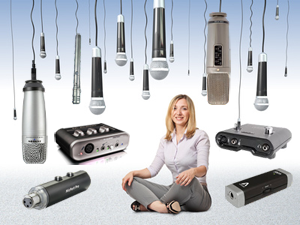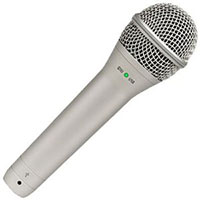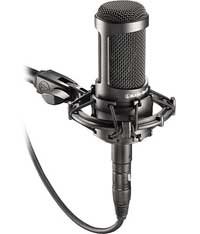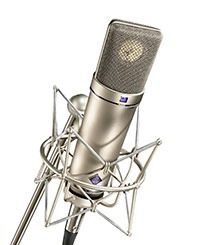 This is week 5 in our series of videos and posts giving you tips for improving the quality of the audio you record in your home studio. All the tips so far (if you’ve missed them, you can start with week one here: Improve The Quality Of The Audio You Record At Home – Tip 1) have shown you quick, easy ways to improve your audio without having to to buy or build anything. But they also had something else in common. They all work to make your audio sound more professional no matter what kind of microphone you are using – cheap or expensive.
This is week 5 in our series of videos and posts giving you tips for improving the quality of the audio you record in your home studio. All the tips so far (if you’ve missed them, you can start with week one here: Improve The Quality Of The Audio You Record At Home – Tip 1) have shown you quick, easy ways to improve your audio without having to to buy or build anything. But they also had something else in common. They all work to make your audio sound more professional no matter what kind of microphone you are using – cheap or expensive.
[genesis_club_wistia_video id=”tsb715yr8g” pt=”75″]
The Microphone Is Not The Most Important Thing
It was quite intentional to NOT make “buying an expensive microphone” the first tip in a series about how to record better audio. Usually, it’s the the first thing people think they need to do in order to record more professional audio. But that simply is not the case. I think it belongs at about number 5 or 6 on the list. If you’ve been trying out all the tips in this series, you’ll know first-hand how to massively improve your audio using the exact same mic you started with, no matter how cheap or expensive it is. Technique — how you use your gear — is by far the most important element.
Better Audio With A Better Mic

Even though I don’t think it’s the most important thing, it doesn’t mean you can’t improve your audio quality by using a different/better microphone. And this week’s tip is that no matter what mic you currently have, you can probably upgrade to the next level for much less money than you thought. For example, if you change from using a $5 computer mic to a $25 USB headset, it’s going to sound better. Cost of upgrade – $20. If you start with the USB headset and switch to using a $49 USB handheld mic like the Samson Q2U, the quality will skyrocket dramatically. Then moving from that to a $65 large-diaphragm USB mic like the Samson C01U, the quality jumps again. Make the switch to an audio interface with a standard large-diaphragm condenser microphone for a couple hundred dollars and the quality goes up again, and so on.

Generally speaking, for vocals – a large-diaphragm condenser mic like this Audio-Technica AT2035 – will work best for vocals. HOWEVER, there are two other types of microphone that sound terrific on vocals. Believe it or not, shotgun mics – typically used for video (such as the Sennheiser MKH416), sound great as close-up vocal mics. And though you would typically stay away from cheap dynamic microphones for vocal recording, certain TYPES of dynamics – called broadcast dynamics – can sound fantastic – such as the Electro-Voice RE 20 or the Shure SM7. In fact, since those mics are dynamic mics AND they have a cardioid pickup pattern, you get a double-dose of audio quality improvement. The cardioid pattern helps reject noise from most parts of a room, AND the fact that a dynamic mic is less sensitive to ambient noise overall, you get a lot less noise (air conditioning hum, computer drives spinning, etc) than with a large diaphragm condenser.
There are too many mics to mention, and we can’t try them all. So here is my advice if you do not already have a really good microphone. If you are not currently using one, try a large USB mic like the Samson C01U. The next step to improving even more – when you are ready to invest a few hundred dollars – is to get yourself an audio interface such as this Focusrite Scarlett 2i2 or Scarlett Solo, which plug into your computer via USB. Then get a standard (meaning NOT USB) large-diaphragm condenser mic such as the Audio-Technica AT2035 and plug it into your interface. That kind of set-up — a large diaphragm condenser mic plugged into an audio interface device — is what even the highest-end professional studios use.

Over time, and as your budget allows, you’ll want to try different mics. Here’s what’s on my wish-list right now. I’m saving for a Sennheiser MKH 416 shotgun mic for voice-over work. And though I drool over the thought of having one, it will be some time before I’ll be able to afford – or at least convince my wife that we can afford – a Neumann U-87, which currently would set you back about $3,600. Well, maybe some day.
So this week’s tip is that regardless of what microphone you are currently using, you can almost certainly upgrade for a lot less money than you thought. I also told you what kind of mics usually work best for vocals, and I mentioned a few specific mics you can try out. Don’t forget to tune in next week for yet another tip for dramatically improving the quality of the audio you record in your home studio. See you then!
Don’t Miss Out
Make sure you don’t miss any of the tips in this series. Put your email into the form below and get not only the rest of this series as it rolls out, but also the first 8 videos in our tutorial course “The Newbies Guide To Audio Recording Awesomeness 1: The Basics With Audacity.” This course shows you how to set up and start using your home recording studio for a budget of about five bucks (or less) in about 30 minutes.
We will not spam you with e-mails! We typically don’t send more than one message per week, and each of those will only be intended to help you make better audio recordings in your home studio.